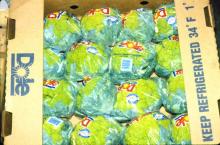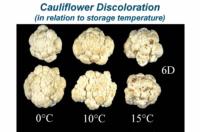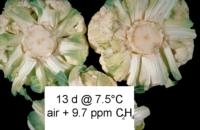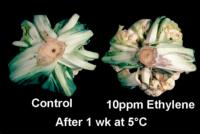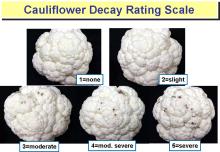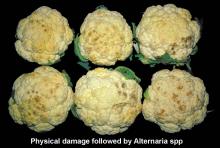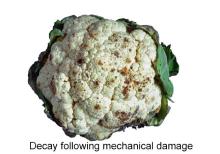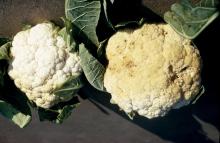Product Description
Maturity and Quality
Cauliflowers are selected for size and compactness of the head or curd. Mature curds are at least 15 cm (6 inches) in diameter. Loose or protruding floral parts, creating a ‘ricy’ appearance, are a sign of overmaturity. Cauliflower is packaged after being closely trimmed into single layer cartons of 12 to 24 heads, with 12’s most common.
Cauliflower is primarily marketed with closely trimmed leaves and overwrapped with perforated film. Overwraps should provide four to six 1/4-inch holes per head to allow adequate ventilation.
A firm and compact head of white to cream white curds surrounded by a crown of well-trimmed, turgid green leaves. Additional quality indices are size, freedom from severe yellowing due to sunlight exposure, freedom from handling defects and decay, and an absence of ‘riciness’.
U.S. grade No. 1
Postharvest Handling and Storage
0°C (32°F)
Storage of cauliflower is generally not recommended for more than 3 weeks for good visual and sensory quality. Wilting, browning, yellowing of leaves, and decay are likely to increase following storage beyond 3-4 weeks or at higher than recommended storage temperatures.
| Temperature °C | Temperature °F | ml CO2/kg·hr |
| 0 | 32 | 8-9 |
| 5 | 41 | 10-11 |
| 10 | 50 | 16-18 |
| 15 | 59 | 21-25 |
| 20 | 68 | 37-42 |
| 25 | 77 | 43-48 |
To calculate heat production, multiply ml CO2/kg·hr by 440 to get BTU/ton/day or by 122 to get kcal/metric ton /day.
Cauliflower is highly sensitive to exogenous ethylene. Discoloration of the curd and accelerated yellowing and detachment of wrapper leaf stalks will result from low levels of ethylene during distribution and short-term storage. Do not mix loads such as apples, melons and tomatoes with cauliflower.
95-98%
Cauliflower is highly sensitive to exogenous ethylene. Discoloration of the curd and
Controlled or modified atmospheres offer moderate to little benefit to cauliflower. Injury from low O2 (<2%) or elevated CO2 (>5%) may not be visual and will only be evident after cooking. When the curds become grayish, extremely soft, and emit strong off-odor. Higher levels (>10%) of CO2 will induce this injury within 48 hours. Combined low O2 and slightly elevated CO2 levels (3-5%) delay leaf yellowing and the onset of curd browning by a few days.
Temperature & Controlled Atmosphere Photos
Disorders
Freezing Injury. Freezing injury will be initiated at -0.8°C (30.6°F). Symptoms of freezing injury include a watersoaked and greyish curd and watersoaked or wilted crown leaves. The curd will become brown and gelatinous in appearance following invasion by soft-rot bacteria.
Harvesting should be done with great care to prevent damage to the highly sensitive turgid curds. Cauliflower should never be handled by the curd portion of the head. Cauliflower should never be allowed to roll or scuff across a harvest -conveyor belt, table, or other work surface. Bruising is very common and leads to rapid browning and decay when attention to careful harvest and handling practices are not followed.
Diseases are an important source of postharvest loss, particularly in combination with rough handling and poor temperature control. A large list of bacterial and fungal pathogens cause postharvest losses in transit, storage, and to the consumer. Bacterial Soft-Rot (primarily Erwinia and Pseudomonas), Black Spot (Alternaria alternata.), Grey Mold (Botrytis cinerea), and Cladosporium Rot are common disorders.
Special Considerations
For fresh-cut applications, the sensitivity of cauliflower to improper modified atmosphere (See Responses to CA) demands very careful selection of packaging films and proper temperature management.




